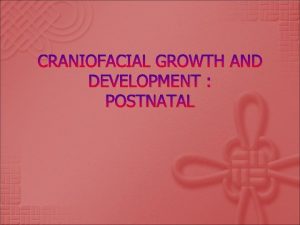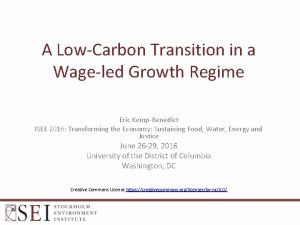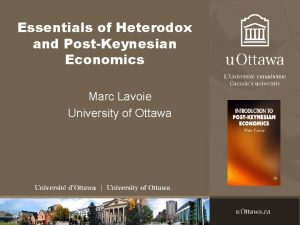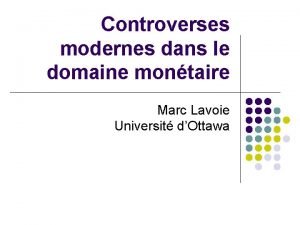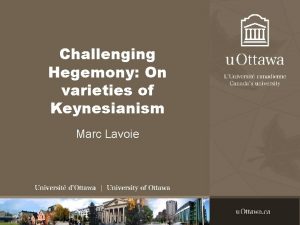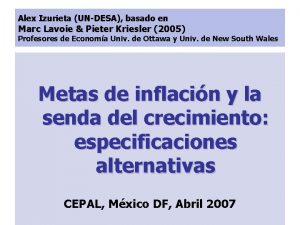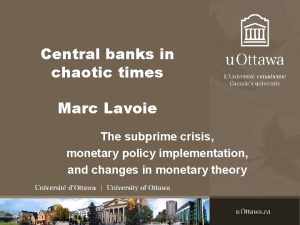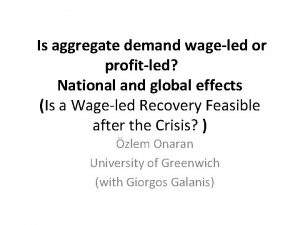Wageled Growth Concept Theories and Policies Marc Lavoie




















- Slides: 20

Wage-led Growth: Concept, Theories and Policies Marc Lavoie* and Engelbert Stockhammer**

Preliminary remarks • The wage share has been falling in several countries over the last decades. • There has been a polarization of incomes, even within wage and salary income. • Average wages and average labour compensation have not kept up with productivity increases. • Growth processes seem to have become more unbalanced. • Export-led growth and finance-led growth regimes do not seem to be sustainable or stable. RDW Conference, ILO, Geneva, 8 July 2011

New perspectives on wages and economic growth: potentials of wage-led growth • • • 1. Conceptual clarification 2. Why has the wage share been falling? 3. A mapping of wage-led and profit-led demand 4. A mapping of wage-led and profit-led supply 5. The impact of income polarization 6. The impact of financialization RDW Conference, ILO, Geneva, 8 July 2011

DISTRIBUTION AND GROWTH. A CONCEPTUAL FRAMEWORK RDW Conference, ILO, Geneva, 8 July 2011

The crucial distinction • One has to distinguish between the policies that are being pursued in a country to promote a certain kind of growth regime; • And the economic growth regime that this country is actually into, and hence how the economy will react to the policies being put forward. RDW Conference, ILO, Geneva, 8 July 2011

Pro-labour and pro-capital distributional policies Distributional policies Policies Other factors Pro-capital Pro-labour ’Labour market ’Welfare state’ flexibility’ Increase minimum wages technology Abolish minimum wages Strengthen collective Globalisation Weaken collective Financialization bargaining Impose wage moderation Results Changes Weak wage growth Rising real wages Wage share ↓ Stable (or ↑) wage share Increased wage Decreased wage dispersion RDW Conference, ILO, Geneva, 8 July 2011 in

Definition of profit-led and wage-led economic regimes Overall impact on the economy Favourable Unfavourable Income An increase in Profit-led Wage-led distribution the profit regime change share imposed on An increase in Wage-led Profit-led society the wage regime share regime RDW Conference, ILO, Geneva, 8 July 2011

Viability of growth regimes Distributional policies Economic Profit-led regime Wage-led Pro-capital Pro-labour Profit-led Stagnation or growth unstable process growth Stagnation or Wage-led unstable growth process RDW Conference, ILO, Geneva, 8 July 2011

Actual growth strategies Distributional policies and strategies Pro-capital Economic Profit-led regime Pro-labour ‘Trickle-down Neoliberalism’ – ‘Doomed social Supply-side policies will reforms’ generate aggregate demand Wage-led TINA ‘Neoliberalism in practice’ – Postwar social Unstable and has to rely on Keynesianism exogenous growth drivers (credit Golden age -led growth, export-led growth) RDW Conference, ILO, Geneva, 8 July 2011

DEMAND REGIMES RDW Conference, ILO, Geneva, 8 July 2011

Demand regimes, Y=C+I+NX+G • An increase in the Wage Share leads to • Effect on consumption (cw > cp) • Effect on investment – Domestic effect • Effect on net exports – Total effect RDW Conference, ILO, Geneva, 8 July 2011 WS ↑ C↑ I (↑) ↓ NX ↓ Y ↓↑

Economic structure: wage-led and profit-led demand regimes Demand regime Profit-led Wage-led Economic Small differentials in propensities to Propensity out of wages is structure consume much higher than the propensity out of profits Investment is highly sensitive to Investment is not sensitive profitability and accelerator parameter is to low profitability accelerator parameter and is high Very open economy with high net export Relatively closed economy price elasticity with low net export price elasticity RDW Conference, ILO, Geneva, 8 July 2011

Effects of an increase in the wage share and demand regimes Effect on total demand (or the rate of capacity utilization) Positive Effect on Positive investment (or the Negative Wage-led demand wage-led investment rate of accumulation) Negative Wage-led demand Profit-led demand profit-led investment RDW Conference, ILO, Geneva, 8 July 2011

Effects of an increase in the wage share in the canonical Kaleckian model S 0 I, S S 1 Ica E I 0 I q 0 qc RDW Conference, ILO, Geneva, 8 July 2011 qca q

Effects of an increase in the wage share in the post-Kaleckian model S 0 I, S S 1 Ica I 1 I 2 I 0 q 0 qc RDW Conference, ILO, Geneva, 8 July 2011 qca q

SUPPLY REGIMES: EFFECT ON CAPITAL STOCK AND PRODUCTIVITY RDW Conference, ILO, Geneva, 8 July 2011

Economic structure: wage-led and profit-led productivity regimes Productivity regime Economic Profit led Wage restraint leads to productivity-enhancing investment structure Higher real wage growth leads to slower productivity growth Wage led Wage growth has strong positive effects on labour effort and productivity–enhancing investments Higher real wage growth leads to faster productivity growth (Webb effect) RDW Conference, ILO, Geneva, 8 July 2011

Interaction between productivity and demand • There is a lot of empirical evidence showing that faster overall growth, and faster growth in manufacturing, leads to faster productivity growth. • This is the so-called Kaldor-Verdoorn effect • Thus, the effects of an increase in wages or the wage share, besides their direct effect on productivity, will have an effect on aggregate demand that will have additional indirect effects on productivity. RDW Conference, ILO, Geneva, 8 July 2011

Total productivity effect of an increase in the wage share, when the partial productivity regime is wage led Demand Regime Direct (partial) Indirect Overall combined productivity and effect (Kaldor- demand effect Verdoorn effect) Profit led Positive Negative Positive or negative Wage led Positive RDW Conference, ILO, Geneva, 8 July 2011 Positive

Conclusion: The danger of an error of composition • Several countries wish to pursue an export-led, restraining wages to gain a competitive advantage. • But at the level of the whole world, planet earth is a closed economy. All countries cannot be net exporters. • Even the eurozone is a relatively closed area. • Thus what really counts are the effects of an increase in the wage share on domestic aggregate demand. • Empirical studies show that most countries are in a wage-led domestic demand regime. • A wage-led growth strategy is thus conducive to the most sustainable growth process. RDW Conference, ILO, Geneva, 8 July 2011
 Lewis lavoie
Lewis lavoie Jde wina
Jde wina Tammie lavoie
Tammie lavoie Principles of human growth and development
Principles of human growth and development Personal attraction meaning
Personal attraction meaning Theories of craniofacial growth
Theories of craniofacial growth Growth is defined as an increase in
Growth is defined as an increase in Monocots eudicots
Monocots eudicots Primary growth and secondary growth in plants
Primary growth and secondary growth in plants Chapter 35 plant structure growth and development
Chapter 35 plant structure growth and development Carothers equation
Carothers equation Geometric vs exponential growth
Geometric vs exponential growth Neoclassical growth theory vs. endogenous growth theory
Neoclassical growth theory vs. endogenous growth theory Organic vs inorganic growth
Organic vs inorganic growth Security program and policies principles and practices
Security program and policies principles and practices Recruitment selection and induction process
Recruitment selection and induction process Security program and policies principles and practices
Security program and policies principles and practices Security program and policies principles and practices
Security program and policies principles and practices Security program and policies principles and practices
Security program and policies principles and practices Security program and policies principles and practices
Security program and policies principles and practices Section 5-1 how populations grow answer key
Section 5-1 how populations grow answer key





